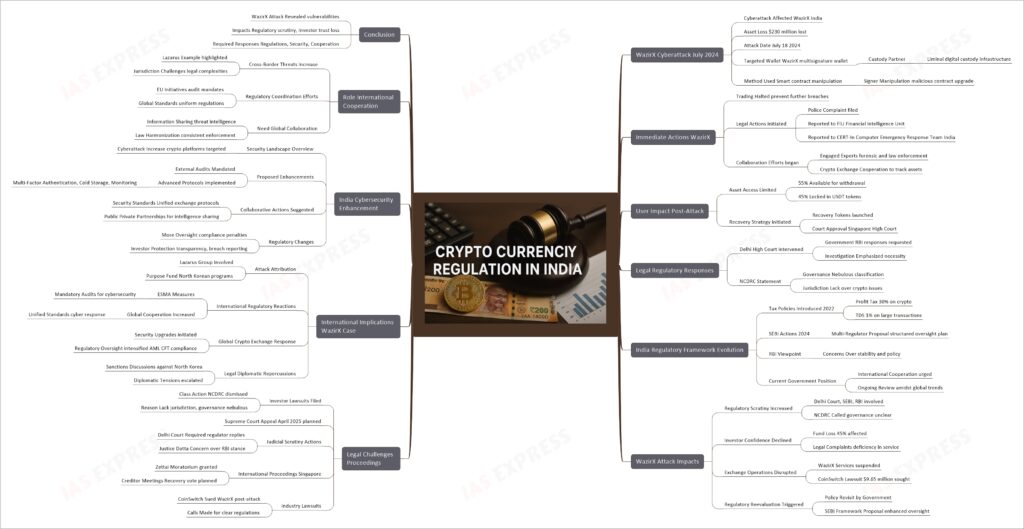Crypto Currency Regulation in India [WazirX Case]

From Current Affairs Notes for UPSC » Editorials & In-depths » This topic
IAS EXPRESS Vs UPSC Prelims 2024: 80+ questions reflected
In July 2024, WazirX, one of India’s largest cryptocurrency exchanges, suffered a significant cyberattack, resulting in the loss of over $230 million in digital assets. This incident has intensified discussions about the regulatory framework governing cryptocurrencies in India and highlighted the urgent need for clear policies to protect investors and maintain financial stability.

The WazirX Cyberattack: A Detailed Examination
In July 2024, WazirX, a leading Indian cryptocurrency exchange, experienced a significant cyberattack, resulting in the loss of approximately $230 million in digital assets.
- Incident Overview:
- Date: July 18, 2024.
- Target: WazirX’s multisignature wallet, managed in collaboration with Liminal’s digital asset custody infrastructure.
- Method: Attackers manipulated the wallet’s signers into approving a malicious smart contract upgrade, granting unauthorized access to the funds.
- Immediate Actions Taken by WazirX:
- Suspension of Trading: All trading activities were halted to prevent further unauthorized transactions.
- Legal Measures:
- Filed a police complaint.
- Reported the incident to the Financial Intelligence Unit (FIU) and the Indian Computer Emergency Response Team (CERT-In).
- Collaboration Efforts:
- Engaged with forensic experts and law enforcement agencies to trace the stolen funds and identify the perpetrators.
- Cooperated with other cryptocurrency exchanges to track and recover the assets.
- Impact on Users:
- Asset Accessibility:
- 55% of user crypto assets were made available for trading or withdrawals.
- The remaining 45% were converted to USDT-equivalent tokens and locked.
- Recovery Plan:
- Introduction of a restructuring plan allowing users to recover up to 85% of stolen funds through Recovery Tokens.
- This plan received approval from the Singapore High Court.
- Asset Accessibility:
- Legal and Regulatory Responses:
- Delhi High Court’s Involvement:
- Sought responses from the government and the Reserve Bank of India (RBI) regarding the cyberattack.
- Emphasized the need for a thorough investigation into the incident.
- National Consumer Disputes Redressal Commission (NCDRC):
- Described the current cryptocurrency governance regime as “nebulous”.
- Indicated that the consumer court lacks jurisdiction over such cases, highlighting regulatory ambiguities.
- Delhi High Court’s Involvement:
The WazirX cyberattack not only exposed vulnerabilities within individual exchanges but also underscored the pressing need for a robust and clear regulatory framework to safeguard investors and maintain trust in India’s burgeoning cryptocurrency market.
India’s Evolving Cryptocurrency Regulatory Framework
India’s approach to cryptocurrency regulation has undergone significant changes, reflecting the dynamic nature of the digital asset landscape.
- Initial Stance and Taxation Policies:
- Taxation Measures:
- In 2022, the Indian government introduced a 30% tax on profits from cryptocurrency transactions.
- Additionally, a 1% Tax Deducted at Source (TDS) was imposed on crypto transactions exceeding specified thresholds.
- Taxation Measures:
- Regulatory Developments:
- Securities and Exchange Board of India (SEBI):
- In 2024, SEBI proposed a multi-regulator framework to oversee cryptocurrency activities, aiming for a structured regulatory approach.
- Reserve Bank of India (RBI):
- The RBI has consistently expressed concerns about cryptocurrencies, citing potential risks to financial stability and monetary policy.
- Securities and Exchange Board of India (SEBI):
- Government’s Current Position:
- International Collaboration:
- The Indian government emphasizes the need for international cooperation in formulating effective cryptocurrency regulations, acknowledging the borderless nature of digital assets.
- Ongoing Review:
- As of early 2025, authorities are reassessing their stance on cryptocurrencies in light of global policy shifts, indicating potential updates to the regulatory framework.
- International Collaboration:
These developments underscore India’s cautious yet evolving approach to cryptocurrency regulation, balancing innovation with economic and financial stability considerations.
Impact of the WazirX Cyberattack on India’s Cryptocurrency Landscape
The WazirX cyberattack in July 2024 had profound implications for India’s cryptocurrency ecosystem, influencing regulatory perspectives, investor confidence, and the operations of crypto exchanges.
- Regulatory Scrutiny Intensified:
- Government and Regulatory Bodies’ Response:
- The Delhi High Court sought responses from the Reserve Bank of India (RBI) and the Securities and Exchange Board of India (SEBI) regarding the incident, emphasizing the need for a comprehensive regulatory framework.
- The National Consumer Disputes Redressal Commission (NCDRC) labeled the existing cryptocurrency governance as “nebulous,” highlighting the absence of clear regulations.
- Government and Regulatory Bodies’ Response:
- Investor Confidence Shaken:
- Loss of Funds:
- Approximately 45% of user crypto assets were affected by the breach, leading to significant financial losses for investors.
- Legal Actions by Investors:
- Investors filed complaints citing “deficiency in service” by WazirX, arguing inadequate security measures facilitated the cyberattack.
- Loss of Funds:
- Operational Challenges for Crypto Exchanges:
- Suspension of Services:
- WazirX halted trading activities and restricted withdrawals post-attack, disrupting user access to funds.
- Litigation from Industry Peers:
- CoinSwitch, a rival exchange, sued WazirX to recover $9.65 million in trapped funds resulting from the attack.
- Suspension of Services:
- Catalyst for Regulatory Re-evaluation:
- Government’s Stance:
- The Indian government began revisiting its position on cryptocurrencies, considering global regulatory changes and the need for robust domestic policies.
- Proposals for Enhanced Oversight:
- SEBI proposed a multi-regulator framework to oversee cryptocurrency activities, aiming for structured and comprehensive regulation.
- Government’s Stance:
The WazirX incident underscored the urgent need for clear regulatory guidelines, robust security protocols, and measures to restore and maintain investor trust in India’s cryptocurrency market.
Legal Challenges and Court Proceedings Following the WazirX Cyberattack
The WazirX cyberattack led to significant legal challenges and court proceedings, reflecting the complexities and ambiguities in India’s cryptocurrency regulatory landscape.
- Investor Lawsuits and Consumer Court Rulings:
- Class Action Dismissal:
- In January 2025, a group of 40 investors filed a class-action lawsuit against WazirX in the National Consumer Disputes Redressal Commission (NCDRC), alleging a deficiency in services due to the cyberattack.
- The NCDRC dismissed the lawsuit in March 2025, citing the “nebulous” nature of cryptocurrency governance in India and stating that the commission lacked jurisdiction over the matter.
- Supreme Court Appeal:
- Following the dismissal, the investors planned to appeal to the Supreme Court of India in April 2025, seeking recovery of lost funds and clearer legal recognition of cryptocurrencies.
- Class Action Dismissal:
- Judicial Scrutiny and Regulatory Oversight:
- Delhi High Court’s Intervention:
- The Delhi High Court sought responses from the Reserve Bank of India (RBI) and the Securities and Exchange Board of India (SEBI) regarding the WazirX cyberattack, emphasizing the need for a comprehensive regulatory framework for cryptocurrencies.
- Justice Sachin Datta expressed concern over the RBI’s stance of non-regulation, highlighting potential threats to the financial system.
- Delhi High Court’s Intervention:
- International Legal Proceedings:
- Singapore High Court’s Involvement:
- WazirX’s parent company, Zettai Pte Ltd, filed for a moratorium in the Singapore High Court to restructure and address claims from creditors and investors.
- In January 2025, the court allowed Zettai to hold meetings with creditors to vote on a proposed recovery plan for the lost assets.
- Singapore High Court’s Involvement:
- Industry Reactions and Peer Litigations:
- CoinSwitch Lawsuit:
- CoinSwitch, a rival cryptocurrency exchange, filed a lawsuit against WazirX in August 2024 to recover approximately $9.65 million in funds trapped due to the cyberattack.
- Calls for Regulatory Clarity:
- The incident intensified demands within the cryptocurrency industry for clearer regulations and legal frameworks to govern digital assets and protect investors.
- CoinSwitch Lawsuit:
These legal proceedings underscore the urgent need for well-defined regulations and robust legal frameworks to address the challenges posed by the rapidly evolving cryptocurrency landscape in India.
International Implications of the WazirX Cyberattack
The WazirX cyberattack not only affected the Indian cryptocurrency landscape but also had significant international ramifications, highlighting the global nature of cybersecurity threats in the digital asset domain.
- Attribution to International Cybercriminals:
- Lazarus Group’s Involvement:
- Investigations revealed that the Lazarus Group, a notorious North Korean hacking collective, was responsible for the WazirX breach.
- This group has a history of targeting financial institutions and cryptocurrency platforms to fund state activities, including nuclear programs.
- Lazarus Group’s Involvement:
- Global Regulatory Responses:
- European Union’s Enhanced Cybersecurity Measures:
- In response to rising cyber threats, including the WazirX incident, the European Securities and Markets Authority (ESMA) advocated for mandatory external audits of crypto companies’ cyber defenses to bolster consumer protection.
- Collaborative International Efforts:
- The attack underscored the necessity for cross-border cooperation in addressing cyber threats, leading to increased dialogue among nations on establishing unified cybersecurity standards for cryptocurrency platforms.
- European Union’s Enhanced Cybersecurity Measures:
- Impact on Global Cryptocurrency Exchanges:
- Heightened Security Protocols:
- Major exchanges worldwide began reevaluating and strengthening their security infrastructures to prevent similar breaches, recognizing the sophisticated tactics employed by groups like Lazarus.
- Regulatory Scrutiny Intensified:
- Regulatory bodies in various countries increased oversight of cryptocurrency exchanges, emphasizing the importance of compliance with anti-money laundering (AML) and combating the financing of terrorism (CFT) regulations.
- Heightened Security Protocols:
- Legal and Diplomatic Repercussions:
- Sanctions and Legal Actions:
- The involvement of a state-sponsored group like Lazarus led to discussions on imposing sanctions and taking legal actions against entities and nations harboring cybercriminals.
- Diplomatic Strains:
- The incident contributed to diplomatic tensions, particularly concerning North Korea’s alleged state-sponsored cyber activities and their implications for global security.
- Sanctions and Legal Actions:
The WazirX cyberattack served as a stark reminder of the transnational nature of cyber threats in the cryptocurrency sector, prompting a concerted global effort to enhance security measures, regulatory frameworks, and international cooperation to safeguard digital assets.
Strengthening Cybersecurity Measures in India’s Cryptocurrency Sector
The WazirX cyberattack has underscored the critical need for robust cybersecurity measures within India’s cryptocurrency industry.
- Current Security Landscape:
- Prevalence of Cyberattacks:
- The WazirX incident is part of a broader trend of increasing cyberattacks targeting cryptocurrency platforms, highlighting vulnerabilities in existing security frameworks.
- Prevalence of Cyberattacks:
- Proposed Enhancements:
- Mandatory External Audits:
- Regulatory bodies are advocating for compulsory third-party audits of crypto companies’ cyber defenses to ensure resilience against sophisticated attacks.
- Implementation of Advanced Security Protocols:
- Adoption of multi-factor authentication, cold storage solutions, and real-time monitoring systems to detect and prevent unauthorized access.
- Mandatory External Audits:
- Collaborative Efforts:
- Industry-Wide Standards:
- Development of standardized security protocols across all cryptocurrency exchanges to create a unified defense mechanism.
- Public-Private Partnerships:
- Collaboration between government agencies and private sector entities to share threat intelligence and best practices.
- Industry-Wide Standards:
- Regulatory Implications:
- Increased Oversight:
- Regulators are emphasizing the need for stringent compliance with cybersecurity norms, potentially introducing penalties for non-compliance.
- Consumer Protection Measures:
- Mandating transparency in security practices and prompt disclosure of breaches to protect investors and maintain market integrity.
- Increased Oversight:
The WazirX incident serves as a pivotal moment for India’s cryptocurrency sector, highlighting the imperative for enhanced cybersecurity measures and proactive regulatory frameworks to safeguard digital assets and maintain investor confidence.
The Role of International Cooperation in Cryptocurrency Regulation
The WazirX cyberattack has underscored the necessity for international collaboration in regulating the cryptocurrency sector, given its inherently borderless nature and the global reach of cyber threats.
- Cross-Border Cybersecurity Threats:
- Global Nature of Cyberattacks:
- The involvement of the Lazarus Group, a North Korean hacking collective, in the WazirX breach highlights the transnational aspect of cyber threats targeting cryptocurrency platforms.
- Challenges in Jurisdiction:
- Cybercriminals often operate across multiple countries, complicating legal and law enforcement efforts due to differing national laws and enforcement capabilities.
- Global Nature of Cyberattacks:
- International Regulatory Efforts:
- European Union’s Initiatives:
- The European Securities and Markets Authority (ESMA) has advocated for mandatory external audits of crypto companies’ cyber defenses to enhance consumer protection, reflecting a proactive approach to regulation.
- Global Standards Development:
- International bodies are working towards establishing standardized regulations to ensure consistent oversight and security measures across jurisdictions.
- European Union’s Initiatives:
- Necessity for Global Collaboration:
- Information Sharing:
- Enhanced cooperation among countries facilitates the sharing of intelligence on emerging threats, vulnerabilities, and best practices to combat cybercrime effectively.
- Harmonization of Laws:
- Aligning regulatory frameworks can help in addressing the challenges posed by the decentralized and cross-border nature of cryptocurrencies, ensuring more effective enforcement and investor protection.
- Information Sharing:
The WazirX incident serves as a compelling case for the imperative of international cooperation in crafting and enforcing regulations that can effectively address the complexities and risks inherent in the global cryptocurrency market.
Conclusion
The WazirX cyberattack has profoundly impacted India’s cryptocurrency landscape, revealing critical vulnerabilities in security measures and regulatory frameworks. This incident has prompted intensified scrutiny from regulatory bodies, legal challenges, and a reevaluation of cybersecurity protocols within the industry. The case underscores the urgent need for clear regulations, robust security practices, and international cooperation to safeguard digital assets and maintain investor confidence in the evolving cryptocurrency market.
Practice Question
Discuss the implications of the WazirX cyberattack on India’s cryptocurrency regulatory landscape, focusing on legal, financial, and cybersecurity challenges, and the need for international cooperation. (250 words)
If you like this post, please share your feedback in the comments section below so that we will upload more posts like this.

